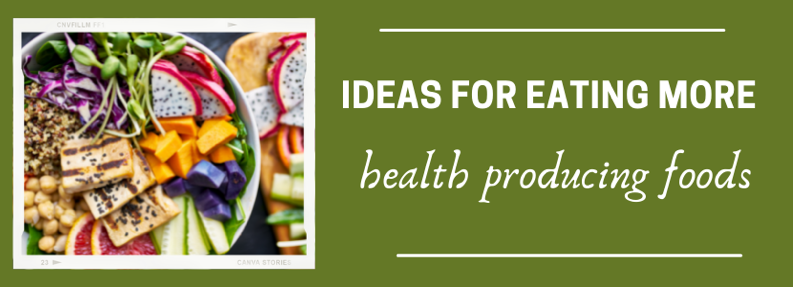
How to Eat More Health Producing Food
Healthy eating. For such a simple concept, why can it be so difficult?
A variety of reasons can inhibit us from succeeding at cleaning up our diets; take for instance:
Stress – high cortisol levels crave sugar and carbs for dopamine release (the feel-good hormone)
Schedules – lack of dedicated time for cooking can result in quick, poor choices
Habits and Beliefs – from childhood on, developed habits and beliefs have formed much of our diets
Additives – can foster addictions difficult to break out of (such as sugar and processed foods)
And that’s just to name a few.
But what you eat on a day to day basis can have a significant impact on both physical and mental health. If you’ve ever “crashed” from consuming too much sugar or suffered from bloating and gas after a decadent meal of carbs, you know the immediate reaction food can have on the body.
So how do we move towards a healthier lifestyle by eating well?
While there are many ways (such as following a certain diet or practicing fasting), one option is to simply add more basics.
And when we say basics, we mean nutrients such as:
- fiber
- vitamins and minerals
- healthy fats
- whole grains
- protein
- anti-oxidants
- omega 3 fatty acids
Easier said than done?
Here are a few of our favorite ways to add these basics into everyday life:
Macro and Buddha Bowls
Made up of a variety of elements, these easy-to-customize bowls are packed full of nutrients and promote a balanced meal.
Macro bowls focus on macronutrients and typically consist of:
- grains (such as quinoa, brown rice, bulgur)
- vegetables (raw and/or cooked like sweet potatoes, spinach, kale, carrots, radish, cauliflower, broccoli, etc.)
- protein (such as salmon, tuna, chicken, or steak)
- healthy fat (like avocado, olive oil, and nuts)
and can be enhanced with:
- fermented foods (such as sauerkraut, kimchi, tempeh)
- seeds (such as sesame, pumpkin, hemp)
- sauces (like teriyaki, green goddess dressing, and tahini)
A Buddha bowl is similar, but is typically vegetarian.
Egg and Tofu Scrambles
Don’t like plain steamed broccoli? Not a fan of spinach? Prefer no mushrooms?
Perfect for any time of day, a scramble can be an easy way to add foods that are healthy, even if not favorable on their own.
For example, try adding:
- peppers
- mushrooms
- greens
- cauliflower
- broccoli
- tomatoes
- avocado
to your next egg or tofu scramble.
Soups and Stews
These one-pot meals can be simple to make and can last for multiple meals.
If you’re too busy to make one from scratch, use a healthy jarred or canned vegetable soup as your base. From there, add as many vegetables as you’d like – onions, garlic, carrots, celery, peas, corn, broccoli, cauliflower, potatoes, etc. as well as any protein like beans, lentils, or chicken.
For extra flavor, top with a homemade pesto made from fresh herbs.
Stir Fry
It’s not just for restaurants! Stir fry can actually be a quick way to whip up a healthy meal.
To make your own:
- sauté peppers, onions, carrots, garlic, snow or snap peas, broccoli, etc.
- cook protein like chicken, shrimp, scallops, steak, and tofu
- add soy, tamari, teriyaki sauce or olive oil
- season with grated ginger, turmeric, lemongrass, etc.
- serve over brown rice
And voila!
These are just a few ways our team creates sustainability for a healthy diet. Now it’s time to find out what works for you!
Add in basics every chance you get – from breakfast to snack to dessert – and feel good about what you are putting in your body.

Leave a Reply